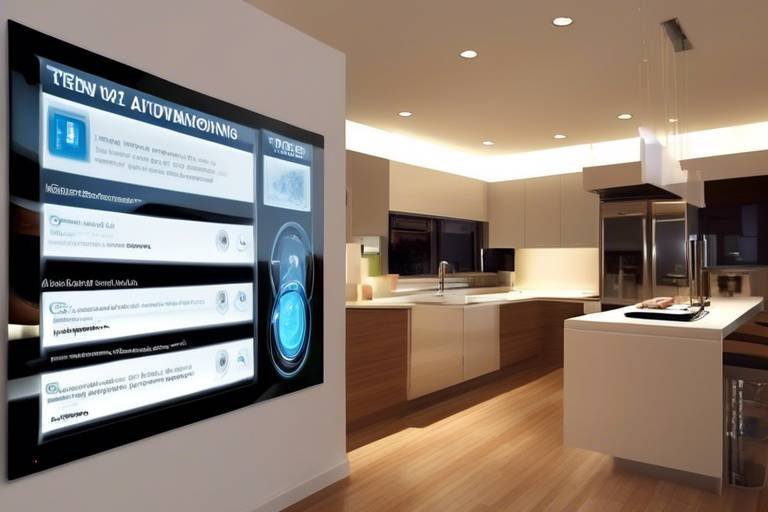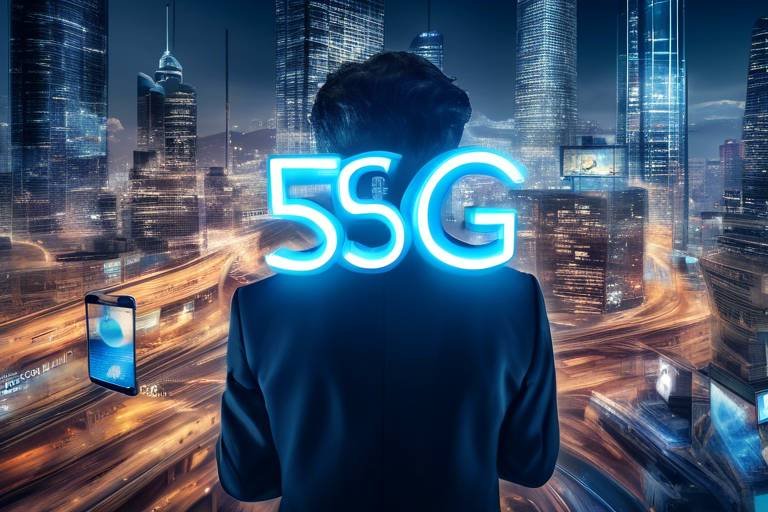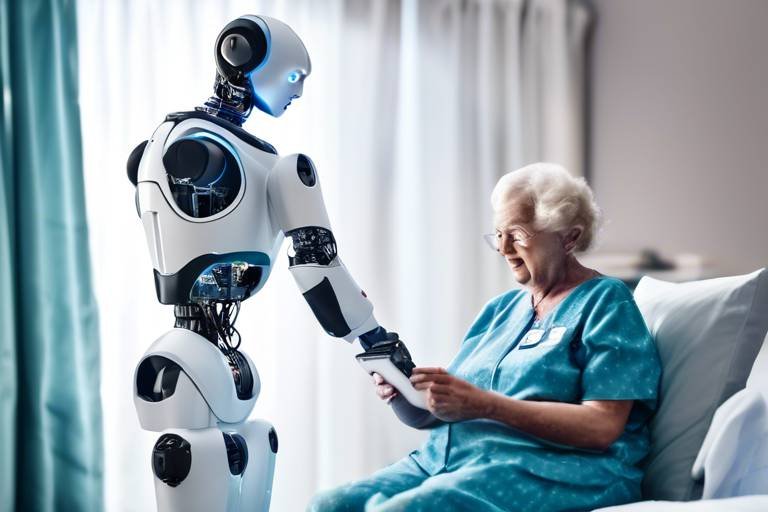Future Trends in Home Automation Technologies
As we step into a new era of technology, the future trends in home automation are not just about convenience; they are about transforming our everyday lives into something extraordinary. Imagine a home that knows you better than you know yourself, adjusting the lights to your favorite hue as you walk through the door, or a security system that alerts you of any unusual activity while you’re away on vacation. This isn't just a dream—it's the reality that emerging technologies are crafting for us. With innovations in smart devices, artificial intelligence, and energy management, the landscape of home automation is evolving rapidly, making our homes not just smarter, but also more efficient and secure.
The integration of various smart devices is revolutionizing home automation. Gone are the days when appliances operated in isolation. Now, we see a harmonious symphony of communication between appliances, lighting, and security systems. This seamless interaction enhances user experience and efficiency, allowing homeowners to control everything from their smartphones or through voice commands. For instance, you can set your thermostat to lower the temperature when you leave for work, while your lights turn off automatically. This level of integration not only simplifies our lives but also contributes to energy savings and improved security.
Artificial intelligence is becoming the backbone of home automation. It enables systems to learn user preferences and behaviors, creating personalized and intuitive environments. Imagine a home that adapts to your daily routine—waking you up with your favorite music at sunrise, brewing coffee as you step into the kitchen, or adjusting the thermostat based on your comfort level. This kind of automation is made possible through AI, which continuously learns and evolves with your habits.
One of the most exciting developments in home automation is the rise of voice-controlled assistants. These digital companions have become central to managing smart devices, allowing users to control everything with simple voice commands. Whether it’s adjusting the lighting, playing music, or checking the weather, voice assistants make it incredibly easy to interact with your home. This enhances accessibility, particularly for those who may struggle with traditional controls.
Today, several voice assistants dominate the market, each offering unique features that enhance the home automation experience:
- Amazon Alexa: Known for its extensive compatibility with various smart devices and skills.
- Google Assistant: Offers superior search capabilities and integration with Google services.
- Apple Siri: Seamlessly integrates with Apple devices for a cohesive ecosystem.
The future of voice technology in home automation looks incredibly promising. With advancements in natural language processing and machine learning, these assistants will become even more intuitive, understanding context and nuances in conversation. Imagine asking your assistant to dim the lights for movie night and having it automatically adjust the ambiance based on your preferences!
As home automation continues to evolve, innovations in home security systems are crucial. Modern security solutions offer advanced features such as remote monitoring, smart locks, and real-time alerts. Homeowners can now monitor their properties from anywhere in the world, receiving instant notifications on their smartphones if anything seems amiss. This level of connectivity not only enhances safety but also provides peace of mind, allowing you to enjoy life without constant worry.
Another significant trend in home automation technologies is the focus on energy efficiency and sustainability. Homeowners are becoming increasingly aware of their carbon footprints, and smart technologies are here to help. From smart thermostats that learn your schedule to energy monitoring systems that track usage, these innovations empower you to make informed decisions about your energy consumption. Automated lighting systems can turn off when you leave a room, ensuring that energy isn’t wasted.
Smart energy management systems take this a step further, allowing you to optimize energy usage effectively. By analyzing your consumption patterns, these systems can suggest ways to reduce energy bills and promote sustainability. Imagine receiving a notification that suggests you run your dishwasher during off-peak hours to save money—now that’s smart living!
Integrating renewable energy sources, such as solar panels, with home automation systems is becoming a popular trend. This not only enables homeowners to manage energy consumption more effectively but also supports a sustainable lifestyle. With the ability to track energy production and usage in real-time, homeowners can make smarter decisions about their energy consumption, leading to a greener future.
The future of home automation holds exciting possibilities. As technology advances, we can expect to see smarter, more efficient, and user-friendly systems that enhance our overall living experience. Imagine a home that not only responds to your commands but anticipates your needs, creating an environment that feels genuinely personalized. With every innovation, we are stepping closer to a future where our homes are not just places to live but extensions of ourselves.
- What is home automation? Home automation refers to the use of technology to control various household systems and appliances remotely, enhancing convenience and efficiency.
- Are smart homes secure? Yes, with the right security systems in place, smart homes can be very secure. Innovations in home security technology provide real-time monitoring and alerts.
- How can home automation save energy? Smart devices can optimize energy usage by learning your habits and adjusting settings accordingly, leading to reduced energy consumption.

Smart Home Devices Integration
In today's fast-paced world, the integration of smart home devices is nothing short of revolutionary. Imagine walking into your house and having the lights adjust automatically to your preferred brightness, your favorite playlist start playing, and the thermostat setting itself to your ideal temperature—all without lifting a finger. This seamless communication between various appliances, lighting systems, and security features creates an environment that is not only comfortable but also efficient. The magic lies in how these devices talk to each other, creating a symphony of automation that enhances your daily life.
One of the most exciting aspects of smart home device integration is the interoperability of different brands and systems. Gone are the days when you had to stick to a single brand to enjoy smart features. Now, devices from different manufacturers can work together harmoniously. For instance, your smart thermostat can communicate with your security system and lighting, adjusting settings based on whether you're home or away. This level of integration not only simplifies your life but also maximizes energy efficiency, saving you money on utility bills.
To illustrate this point, consider the following table that highlights some popular smart home devices and their capabilities:
| Device Type | Brand | Integration Features |
|---|---|---|
| Smart Thermostat | Nest | Works with Google Assistant, Alexa, and Apple HomeKit |
| Smart Security Camera | Ring | Integrates with smart locks and lighting systems |
| Smart Speaker | Amazon Echo | Controls various smart devices via voice commands |
| Smart Lighting | Philips Hue | Can be controlled through multiple platforms including Alexa and Google Home |
As you can see, the possibilities are endless. The ability to control multiple devices through a single interface or voice command not only enhances user experience but also encourages homeowners to adopt more smart technologies. Imagine being able to set your home to "movie mode" with just one command—dim the lights, close the shades, and turn on the entertainment system—all at once!
Moreover, the integration of smart home devices contributes significantly to enhancing home security. For instance, when you leave your home, your smart security system can automatically lock the doors, turn off the lights, and even activate surveillance cameras. This level of automation not only provides peace of mind but also deters potential intruders, knowing that your home is equipped with the latest technology.
In conclusion, the integration of smart home devices is paving the way for a more connected, efficient, and secure living environment. As technology continues to advance, we can expect even more innovative solutions that will further enhance our daily lives. So, why not embrace this wave of change and transform your home into a smart sanctuary?
- What is smart home device integration? Smart home device integration refers to the ability of various smart devices to communicate and work together seamlessly, enhancing user experience and efficiency.
- Do I need to stick to one brand for smart devices? No! Many smart devices from different brands can work together, allowing for greater flexibility in your smart home setup.
- How does smart home integration improve security? Integrated smart devices can automatically lock doors, activate cameras, and adjust lighting when you leave home, enhancing overall security.

Artificial Intelligence in Home Automation
Artificial intelligence (AI) is not just a buzzword; it's a game-changer in the realm of home automation. Imagine walking into your home, and the lights automatically adjust to your preferred brightness, the thermostat sets itself to your ideal temperature, and your favorite playlist starts playing—all without you lifting a finger! This kind of seamless experience is becoming a reality thanks to the integration of AI in smart home technologies.
One of the most significant advantages of AI in home automation is its ability to learn user preferences over time. By analyzing patterns in how you interact with your devices, AI can create a personalized environment that anticipates your needs. For instance, if you typically dim the lights and play soft music in the evening, your smart home system will recognize this habit and do it for you automatically. This not only enhances your comfort but also saves energy, as the system optimizes usage based on your lifestyle.
Moreover, AI-driven home automation systems can provide you with real-time insights into your energy consumption. Imagine having a smart assistant that not only reminds you to turn off unused appliances but also suggests ways to reduce your energy bill. With intelligent monitoring, these systems can identify energy-hogging devices and recommend alternatives or adjustments to your usage habits.
As we delve deeper into the world of AI in home automation, we can’t overlook the role of voice-controlled assistants. These devices are becoming the central hub of smart homes, allowing users to control everything from lighting to security systems with simple voice commands. They’re designed to understand natural language, making interactions feel more intuitive. The more you use them, the better they get at understanding your specific commands and preferences.
Imagine saying, "Hey Google, set the living room temperature to 72 degrees," and having your smart thermostat immediately comply. This is just one example of how voice technology is revolutionizing home automation. Popular voice assistants like Amazon Alexa, Google Assistant, and Apple Siri are not only enhancing convenience but also making technology more accessible to everyone, including those who may not be tech-savvy.
| Voice Assistant | Unique Features |
|---|---|
| Amazon Alexa | Wide range of compatible devices, routines, and skills. |
| Google Assistant | Superior natural language processing and Google integration. |
| Apple Siri | Strong privacy controls and seamless integration with Apple products. |
The future of voice technology in home automation is bright. With advancements in natural language processing and machine learning, these assistants will become even more adept at understanding context and nuance. This means that instead of just responding to specific commands, they will be able to engage in more fluid conversations, making home automation feel less like a task and more like a natural extension of your daily life.
In conclusion, AI is not just enhancing the functionality of home automation systems; it’s transforming how we interact with our living spaces. As technology continues to evolve, we can expect even smarter, more intuitive systems that not only make our lives easier but also contribute to a more sustainable future.
- What is home automation? Home automation refers to the use of technology to control various home systems, such as lighting, heating, and security, remotely or automatically.
- How does AI improve home automation? AI improves home automation by learning user preferences, optimizing energy usage, and enabling intuitive interactions through voice commands.
- What are the most popular voice assistants? The most popular voice assistants include Amazon Alexa, Google Assistant, and Apple Siri, each with unique features that enhance user experience.
- Can home automation save energy? Yes, home automation systems can significantly reduce energy consumption through intelligent monitoring and control of devices.

Voice-Controlled Assistants
In the fast-paced world of home automation, have emerged as the unsung heroes of convenience and accessibility. Imagine walking into your home after a long day, your hands full of groceries, and all you need to do is say, "Turn on the lights!" Suddenly, your living space is illuminated, and you can set down your bags without fumbling for switches. This is the magic of voice technology, and it’s transforming how we interact with our homes.
These intelligent assistants, like Amazon Alexa, Google Assistant, and Apple Siri, act as the central hub for managing various smart devices. They allow users to control everything from lighting and temperature to security systems with simple voice commands. This hands-free functionality not only enhances convenience but also promotes inclusivity for those who may have mobility challenges. It's like having a personal butler who is always ready to help at the sound of your voice!
What makes these voice assistants truly remarkable is their ability to learn and adapt. Over time, they gather data on your routines and preferences, allowing them to offer personalized suggestions. For instance, if you tend to dim the lights and play soft music every evening at 8 PM, your assistant can learn this habit and automate the process for you. It’s not just about convenience; it’s about creating a living environment that feels tailored to your lifestyle.
Moreover, voice-controlled assistants are increasingly being integrated into various home automation systems, providing a cohesive experience. Users can customize their devices and create routines that suit their needs. For example, you can set up a morning routine where saying, "Good morning" prompts your assistant to open the blinds, turn on the coffee maker, and read you the news. The possibilities are endless!
As we look to the future, advancements in natural language processing and machine learning are set to enhance the capabilities of these voice technologies even further. Imagine a world where your assistant understands complex commands, engages in conversational dialogue, and anticipates your needs before you even express them. This evolution will undoubtedly lead to a more intuitive and satisfying user experience.
In conclusion, voice-controlled assistants are not just a trend; they represent a significant leap toward making our homes smarter and more user-friendly. With their ability to simplify tasks and learn from our behaviors, they are reshaping the landscape of home automation. So, whether you're a tech enthusiast or someone looking to make your daily life a bit easier, embracing these voice technologies is a step in the right direction!
- What are voice-controlled assistants?
Voice-controlled assistants are AI-driven devices that allow users to control smart home systems and appliances using voice commands. - How do voice assistants improve home automation?
They provide hands-free control, learn user preferences, and can automate tasks based on routines. - Can I use multiple voice assistants in one home?
Yes, many households use different voice assistants for various purposes, though it’s essential to ensure they are compatible with your smart devices. - Are voice assistants secure?
While they offer convenience, it's crucial to implement security measures, such as strong passwords and privacy settings, to protect your data.

Popular Voice Assistants
When it comes to home automation, voice assistants have become the **unsung heroes** that bring convenience and ease to our daily lives. Imagine walking into your home after a long day, and with just a simple command, your lights turn on, your favorite music starts playing, and the thermostat adjusts to your preferred temperature. This is the magic of voice-controlled technology, and the most popular assistants leading this charge are Amazon Alexa, Google Assistant, and Apple Siri.
Each of these voice assistants has its own unique features that cater to different user preferences and needs. For instance, Amazon Alexa is renowned for its extensive compatibility with a wide range of smart home devices. It boasts thousands of skills, enabling users to control everything from their coffee makers to their security systems with just their voice. Additionally, Alexa's ability to create routines means you can set multiple actions to occur with one command, like saying “Goodnight” to turn off lights, lock doors, and lower the thermostat all at once.
On the other hand, Google Assistant shines with its superior natural language processing capabilities. This means it can understand and respond to more complex queries, making conversations feel more natural. If you ask Google Assistant about the weather, it doesn’t just tell you the temperature; it can also provide a detailed forecast, suggest activities based on the weather, and even remind you of upcoming events. Its integration with Google services adds another layer of functionality, allowing users to manage their calendars and emails effortlessly.
Then there's Apple Siri, which is particularly appealing for users entrenched in the Apple ecosystem. Siri's seamless integration with iOS devices means you can control your smart home devices from your iPhone, iPad, or even your Apple Watch. Siri also emphasizes privacy, ensuring that your data remains secure while still providing personalized experiences. This focus on security is increasingly important as we rely more on technology in our homes.
To summarize the unique offerings of these popular voice assistants, here's a quick comparison:
| Voice Assistant | Key Features | Best For |
|---|---|---|
| Amazon Alexa | Extensive device compatibility, thousands of skills, routine creation | Smart home enthusiasts |
| Google Assistant | Advanced natural language processing, integration with Google services | Users needing detailed information |
| Apple Siri | Seamless integration with Apple devices, strong focus on privacy | Apple ecosystem users |
As technology continues to evolve, the future of these voice assistants looks incredibly promising. With advancements in machine learning and natural language understanding, we can expect even more intuitive interactions. Imagine being able to have a conversation with your assistant that feels as natural as chatting with a friend! The possibilities are endless, and the integration of these voice-controlled technologies into our homes is just the beginning of an exciting journey towards a fully automated lifestyle.
- What is a voice assistant? A voice assistant is a software application that uses voice recognition, natural language processing, and speech synthesis to provide a service through a particular interface.
- Can I use multiple voice assistants in one home? Yes, many households use multiple voice assistants, but it’s essential to ensure they are compatible with your devices to avoid conflicts.
- How do voice assistants enhance home security? Voice assistants can control smart locks, provide security alerts, and even allow remote monitoring through connected cameras.

Future of Voice Technology
The in home automation is not just bright; it's downright dazzling! As we move forward, the integration of natural language processing and machine learning is set to revolutionize how we interact with our smart homes. Imagine walking into your house and simply saying, “I’m home,” and your lights dim, the thermostat adjusts to your preferred temperature, and your favorite playlist starts playing. Sounds like science fiction, right? But it’s becoming a reality!
In the coming years, we can expect voice-controlled systems to become even more intuitive and personalized. These systems will learn from our habits and preferences, offering a level of customization that makes our homes feel truly ours. For instance, if you often ask your assistant to turn on the coffee maker at 7 AM, it will not only remember this request but might even suggest brewing a fresh pot based on your calendar events or morning routines. This level of automation will make daily life smoother and more enjoyable.
Additionally, advancements in voice recognition technology will lead to improved accuracy in understanding commands. No more repeating yourself or yelling at your device! The systems will be able to recognize different voices and respond accordingly, tailoring the experience for each family member. For example, when your child asks for a bedtime story, the assistant will know to play their favorite tale, while you might get a news update or a weather report.
Moreover, the integration of voice technology with other smart home devices will create a cohesive ecosystem. Imagine this scenario: You’re cooking dinner, and you need to check your grocery list. Instead of reaching for your phone or tablet, you can simply ask your voice assistant to read it out loud. It’s like having a personal sous-chef who not only helps you in the kitchen but also manages your home’s entire operation!
As we explore these possibilities, it's crucial to consider the challenges that come with such advancements. Issues related to privacy and security must be addressed. Homeowners will need to feel confident that their voice data is secure and used responsibly. Companies will have to prioritize transparency and give users control over their information. The balance between convenience and privacy will be a critical factor in the widespread adoption of these technologies.
In conclusion, the future of voice technology in home automation is poised to enhance our living experiences significantly. With the promise of smarter, more personalized interactions, we are on the brink of a new era where our homes will respond to us in ways we never thought possible. So, buckle up and get ready for a ride into the future of smart living!
- What is voice technology in home automation? Voice technology allows users to control smart home devices through voice commands, making it easier to manage various tasks hands-free.
- How will voice technology improve in the future? Future improvements will focus on better natural language processing, personalized experiences, and enhanced security measures.
- Are there privacy concerns with voice-controlled devices? Yes, privacy is a significant concern, as users must ensure their data is secure and used responsibly.
- Can voice assistants recognize different voices? Yes, advancements in voice recognition technology will enable systems to differentiate between users and tailor responses accordingly.

Home Security Innovations
In today's fast-paced world, are not just an option; they are a necessity. With the rise in smart home technology, homeowners now have access to an array of advanced security solutions that offer peace of mind and enhanced safety. Imagine being able to monitor your home from anywhere in the world, receiving real-time alerts about suspicious activities, and even controlling your locks and cameras with just a few taps on your smartphone. These innovations are transforming the way we think about home security.
One of the most significant advancements in this realm is the development of smart locks. Unlike traditional locks, smart locks allow homeowners to grant access remotely. You can easily let in a friend or a service person without being physically present. Many smart locks come equipped with features such as keyless entry, which means no more fumbling for keys or worrying about lost ones. Some even have built-in cameras, enabling you to see who is at your door before granting access. This level of control not only enhances security but also adds a layer of convenience that is hard to beat.
Another exciting innovation is the use of motion sensors and smart cameras. These devices can detect movement and send alerts to your smartphone, allowing you to monitor your property in real time. For instance, if someone approaches your home while you’re away, you’ll receive an instant notification, and you can even watch the live feed from your camera. Many of these systems utilize artificial intelligence to differentiate between familiar faces and strangers, reducing false alarms and providing a more tailored security experience.
Furthermore, the integration of alarm systems with smart home devices is becoming increasingly common. Modern alarm systems can be programmed to work in conjunction with other smart devices, such as lights and thermostats. For example, if an intruder is detected, your lights can automatically turn on, creating the illusion that someone is home. This not only deters potential burglars but also helps to ensure your home remains safe.
To give you a clearer picture of the current home security innovations, here’s a quick comparison table of popular smart security features:
| Feature | Description | Benefits |
|---|---|---|
| Smart Locks | Keyless entry, remote access | Convenience, enhanced security |
| Smart Cameras | Real-time monitoring, AI detection | Improved safety, reduced false alarms |
| Motion Sensors | Detects movement, sends alerts | Immediate notifications, peace of mind |
| Integrated Alarm Systems | Works with other smart devices | Comprehensive safety, deterrence |
As we look to the future, it’s clear that home security innovations will continue to evolve. The combination of AI, IoT (Internet of Things), and enhanced connectivity will lead to even smarter systems that can adapt to our lifestyles and preferences. Imagine a home that not only protects you but also learns your habits, adjusting its security measures accordingly. The possibilities are endless, and the future of home security is indeed bright.
- What are smart locks? Smart locks are keyless entry systems that allow homeowners to control access remotely through smartphones or other devices.
- How do smart cameras work? Smart cameras provide real-time video feeds and can send alerts based on motion detection, often utilizing AI to reduce false alarms.
- Can I integrate my alarm system with other smart devices? Yes, many modern alarm systems can be integrated with other smart home devices for enhanced security and convenience.
- Are home security innovations expensive? While some systems can be costly, there are various options available to fit different budgets, making smart security accessible to many homeowners.

Energy Efficiency and Sustainability
In today's world, where the conversation about climate change and environmental responsibility is more urgent than ever, energy efficiency and sustainability have become paramount in home automation technologies. Homeowners are increasingly looking for ways to not only enhance their living spaces but also to reduce their carbon footprint. This shift is not just a trend; it's a necessity. Imagine a home that not only understands your needs but also actively contributes to a healthier planet. That’s the promise of modern home automation.
One of the most significant advancements in this realm is the development of smart thermostats. These devices learn your heating and cooling preferences over time, adjusting automatically to optimize energy usage. For instance, if you're at work during the day, your smart thermostat can lower the temperature to save energy and then warm up the house before you return. This not only leads to substantial savings on your energy bills but also reduces unnecessary energy consumption.
Additionally, energy monitoring systems are gaining traction. They provide real-time data on energy usage, allowing homeowners to pinpoint areas where they can cut back. By identifying energy-hungry appliances, homeowners can make informed decisions about when to use them or if it’s time to upgrade to more efficient models. The integration of these systems into home automation networks means that your home can actively manage and optimize its energy consumption.
Another exciting aspect of energy efficiency is the integration of renewable energy sources, particularly solar panels. Home automation systems can be programmed to prioritize energy drawn from solar panels during peak sunlight hours, reducing reliance on grid energy and lowering electricity costs. This integration not only makes financial sense but also represents a significant step towards sustainability.
Here’s a quick look at how these technologies contribute to energy efficiency:
| Technology | Benefit |
|---|---|
| Smart Thermostats | Automatically adjust temperature settings to save energy. |
| Energy Monitoring Systems | Provide insights into energy usage for informed decision-making. |
| Smart Lighting | Adjust lighting based on occupancy and natural light availability. |
| Renewable Energy Integration | Utilize solar energy to reduce grid dependence and costs. |
Moreover, automated lighting systems can enhance energy efficiency by adjusting based on occupancy and the availability of natural light. For instance, lights can be programmed to turn off when no one is in the room or to dim automatically when sufficient daylight is present. This not only conserves energy but also extends the life of your light bulbs.
In summary, the future of home automation is intricately linked with energy efficiency and sustainability. As technology continues to evolve, we can expect even more innovative solutions that will help homeowners manage their energy consumption while contributing to a greener planet. The integration of smart devices into our homes is not just about convenience; it's about creating a lifestyle that respects our environment and promotes sustainability.
- What are smart thermostats? Smart thermostats are devices that learn your heating and cooling preferences to optimize energy usage and save costs.
- How can home automation help with energy efficiency? Home automation systems can monitor energy usage, control appliances, and integrate renewable energy sources to reduce energy consumption.
- What is renewable energy integration in home automation? It refers to the ability of home automation systems to manage energy consumption using renewable sources like solar panels.
- Can automated lighting systems save energy? Yes, they can adjust based on occupancy and natural light, leading to significant energy savings.

Smart Energy Management Systems
In today's world, where energy consumption is a growing concern, Smart Energy Management Systems (SEMS) are becoming essential for homeowners looking to optimize their energy usage. Imagine a system that not only tracks your energy consumption but also provides actionable insights to reduce waste and save money. That's exactly what SEMS do! By leveraging advanced technologies, these systems can analyze energy patterns, predict usage, and suggest improvements tailored to your lifestyle.
One of the most exciting aspects of SEMS is their ability to integrate with various smart devices throughout your home. For example, when you leave for work, your smart thermostat can adjust the temperature automatically, ensuring you're not heating or cooling an empty house. This not only enhances comfort but also significantly reduces energy bills. Furthermore, with the integration of renewable energy sources, such as solar panels, SEMS can help you manage your energy consumption more effectively, allowing you to utilize your generated energy efficiently.
But how do these systems work? They typically rely on a combination of sensors, smart meters, and software algorithms to monitor energy usage in real-time. Some of the key features of SEMS include:
- Real-time Monitoring: Track your energy consumption as it happens, providing insights into which devices are using the most energy.
- Automated Controls: Set schedules for devices to turn on or off based on your habits, maximizing energy savings without sacrificing comfort.
- Usage Reports: Receive detailed reports that highlight peak usage times and suggest ways to reduce consumption.
Moreover, the potential for cost savings is significant. According to various studies, homeowners can save anywhere from 10% to 30% on their energy bills by implementing a smart energy management system. This not only benefits your wallet but also contributes to a more sustainable future by reducing your overall carbon footprint.
As technology continues to evolve, the future of Smart Energy Management Systems looks bright. With the incorporation of artificial intelligence and machine learning, these systems will become even more intuitive, learning from your habits and making adjustments automatically. Imagine a home that knows when you're away and optimizes energy usage without you lifting a finger!
In conclusion, Smart Energy Management Systems are not just a trend; they are a vital component of modern home automation. By embracing these technologies, homeowners can enjoy enhanced comfort, significant savings, and a positive impact on the environment. The journey towards a smarter, more energy-efficient home has only just begun!
- What is a Smart Energy Management System?
A Smart Energy Management System is a technology that monitors and controls energy consumption in a home, optimizing usage and reducing costs. - How can SEMS save me money?
By providing real-time monitoring and automated controls, SEMS help identify energy waste and suggest ways to reduce consumption, leading to lower energy bills. - Do I need special equipment to use SEMS?
Yes, typically you will need smart meters, sensors, and compatible smart devices to fully utilize a Smart Energy Management System. - Can SEMS integrate with renewable energy sources?
Absolutely! SEMS are designed to work with renewable energy systems, such as solar panels, to optimize energy usage and management.

Renewable Energy Integration
The integration of renewable energy sources into home automation systems is not just a trend; it’s a revolutionary shift towards a more sustainable future. Imagine waking up in a home powered by the sun, where your appliances run efficiently, and your energy bills are significantly lower. This is becoming a reality for many homeowners as technology evolves and the demand for eco-friendly solutions grows. By harnessing renewable energy, such as solar power, homeowners can take control of their energy consumption, ensuring that they not only save money but also contribute to a healthier planet.
One of the most exciting aspects of this integration is the ability to monitor and manage energy usage in real-time. Home automation systems equipped with smart energy management tools provide users with insights into their energy consumption patterns. This means you can see which appliances use the most energy and adjust your usage accordingly. For instance, you could program your washing machine to run during peak sunlight hours when your solar panels are generating the most energy. This not only maximizes your energy savings but also reduces reliance on the grid during high-demand periods.
Moreover, the technology behind renewable energy integration is becoming increasingly sophisticated. Smart inverters, for example, allow homeowners to connect their solar panels directly to their home automation systems. This connection enables features such as:
- Real-time energy monitoring: Track how much energy your solar panels produce and how much your home consumes.
- Automated energy distribution: Automatically redirect excess energy to charge batteries or power specific devices.
- Grid interaction: Sell surplus energy back to the grid or draw from it when necessary, ensuring a constant power supply.
As we move forward, the future of renewable energy integration in home automation looks incredibly promising. With advancements in battery storage technology, homeowners can store excess energy generated during sunny days for use during the night or cloudy days. This not only enhances energy independence but also increases resilience against power outages.
Additionally, as more homeowners adopt renewable energy solutions, the overall demand for fossil fuels decreases, leading to a significant reduction in greenhouse gas emissions. This shift not only benefits individual households but also contributes to global efforts in combatting climate change. The combination of home automation and renewable energy is a powerful duo that empowers homeowners to make smarter, eco-friendly choices.
In conclusion, integrating renewable energy into home automation systems is more than just a technological advancement; it’s a lifestyle choice that promotes sustainability and efficiency. As these technologies continue to evolve, we can expect to see an increasing number of homes equipped with smart systems that not only enhance comfort but also prioritize environmental responsibility.
Q1: What types of renewable energy can be integrated into home automation systems?
A1: The most common types of renewable energy for home integration are solar power, wind energy, and geothermal energy. Solar panels are particularly popular due to their accessibility and efficiency.
Q2: How does integrating renewable energy affect my energy bills?
A2: By using renewable energy, homeowners can significantly reduce their reliance on grid electricity, leading to lower energy bills. Additionally, many regions offer incentives for using renewable energy, which can further decrease costs.
Q3: Can I monitor my renewable energy usage remotely?
A3: Yes! Most modern home automation systems allow you to monitor your energy usage remotely through smartphone apps, giving you real-time insights into your energy production and consumption.

Future of Home Automation
The is not just a glimpse into a tech-savvy world; it’s a revolution that is set to redefine how we live, work, and interact with our homes. Imagine waking up in the morning, and your house is already anticipating your needs. The curtains gently rise to let in the morning light, the coffee machine starts brewing your favorite blend, and the thermostat adjusts to your preferred temperature—all without you lifting a finger. This isn’t science fiction; it's the potential reality of smart homes in the near future.
As we look ahead, several key trends are emerging that promise to make home automation even more integrated and user-friendly. One of the most exciting aspects is the increasing interconnectivity of devices. In the past, homeowners had to juggle multiple apps and systems to manage their smart devices. However, the future points towards a more cohesive ecosystem where devices communicate seamlessly with each other. This integration will not only enhance user experience but also allow for more efficient energy management and security.
Another significant trend is the advancement of artificial intelligence (AI). AI is set to elevate home automation from simple task management to truly intelligent systems that learn and adapt to individual lifestyles. For instance, imagine a system that understands your daily routines and adjusts lighting, temperature, and even entertainment options accordingly. This level of personalization will create environments that feel more intuitive and responsive to our needs.
Moreover, the rise of voice technology is transforming how we interact with our homes. Voice-controlled assistants are becoming more sophisticated, allowing for natural language processing that makes communication with smart devices feel less robotic and more human-like. The future holds the promise of even more advanced voice recognition capabilities, enabling users to issue complex commands or ask for information without any hassle. This will not only enhance convenience but also make technology more accessible to people of all ages.
In addition, the focus on energy efficiency and sustainability is gaining momentum. Home automation systems are increasingly designed to monitor and optimize energy consumption, helping homeowners reduce their carbon footprint. As renewable energy sources, such as solar panels, become more common, integrating these technologies with smart home systems will allow users to manage their energy consumption in real-time. This synergy between automation and renewable energy will not only lead to cost savings but also contribute to a more sustainable future.
To summarize the promising future of home automation, consider the following key points:
- Seamless Integration: Devices will work together more fluidly, enhancing user experience.
- AI Personalization: Systems will learn user preferences for a more tailored experience.
- Advanced Voice Control: Natural language processing will make interactions smoother and more intuitive.
- Energy Efficiency: Smart systems will help reduce energy consumption and promote sustainability.
In conclusion, the future of home automation is bright and filled with possibilities. As technology continues to evolve, we can expect our homes to become smarter, more efficient, and incredibly user-friendly. The integration of AI, voice technology, and sustainable practices will not only enhance our living experiences but also pave the way for a more connected and environmentally conscious world.
Q: What are the main benefits of home automation?
A: Home automation offers numerous benefits, including enhanced convenience, improved energy efficiency, and increased security. By automating daily tasks, homeowners can save time and reduce their carbon footprint.
Q: How does artificial intelligence improve home automation?
A: AI enhances home automation by learning user preferences and behaviors, allowing systems to create personalized environments that adapt to individual lifestyles.
Q: Are voice-controlled assistants secure?
A: While voice-controlled assistants offer convenience, security measures should be taken, such as using strong passwords and enabling two-factor authentication to protect personal information.
Q: Can I integrate renewable energy sources with my home automation system?
A: Yes! Many home automation systems are designed to work with renewable energy sources, allowing homeowners to monitor and manage their energy consumption effectively.
Frequently Asked Questions
- What is home automation?
Home automation refers to the technology that allows you to control various home devices and systems remotely or automatically. This includes lighting, heating, security systems, and appliances, all designed to improve convenience, efficiency, and security in your home.
- How do smart home devices communicate with each other?
Smart home devices typically communicate through a central hub or directly via Wi-Fi, Bluetooth, or Zigbee protocols. This integration allows devices to work together seamlessly, such as adjusting the thermostat when you leave the house or turning on lights when you arrive home.
- What role does artificial intelligence play in home automation?
Artificial intelligence enhances home automation by learning user preferences and behaviors. This enables systems to create personalized experiences, such as adjusting settings based on your daily routines or suggesting energy-saving measures.
- Are voice-controlled assistants essential for smart homes?
While not essential, voice-controlled assistants like Amazon Alexa, Google Assistant, and Apple Siri are incredibly useful. They provide a hands-free way to manage your smart home devices, making it easier to control your environment with simple voice commands.
- What innovations are available in home security systems?
Modern home security systems offer features such as remote monitoring, smart locks, video surveillance, and real-time alerts. These innovations help ensure your home is secure and allow you to monitor your property from anywhere using your smartphone.
- How can home automation contribute to energy efficiency?
Home automation contributes to energy efficiency by allowing homeowners to monitor and control energy usage through smart thermostats, automated lighting, and energy management systems. This can lead to reduced energy bills and a smaller carbon footprint.
- What is a smart energy management system?
A smart energy management system helps homeowners optimize their energy consumption by providing real-time data and control over their energy usage. This includes tracking energy consumption patterns and suggesting ways to save energy.
- Can renewable energy sources be integrated with home automation?
Yes! Integrating renewable energy sources like solar panels with home automation systems allows homeowners to manage their energy consumption more effectively. This integration can lead to significant savings and promote a sustainable lifestyle.
- What does the future hold for home automation technologies?
The future of home automation looks bright, with advancements in technology promising smarter, more efficient, and user-friendly systems. Expect to see increased integration of AI, enhanced security features, and greater focus on energy efficiency as technology evolves.



















